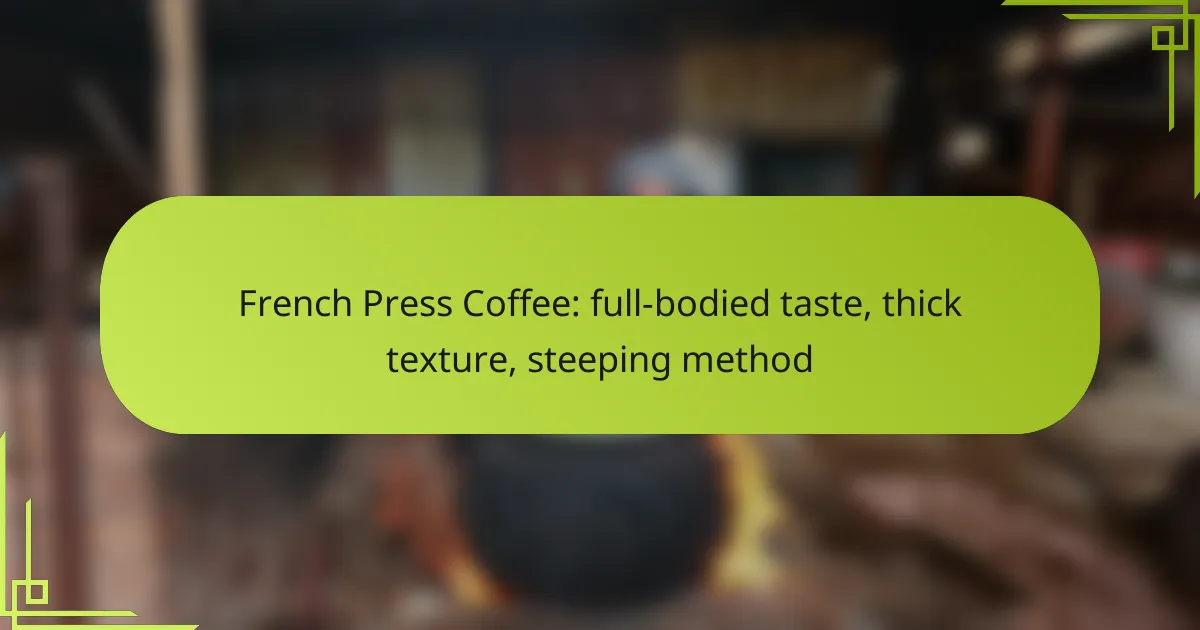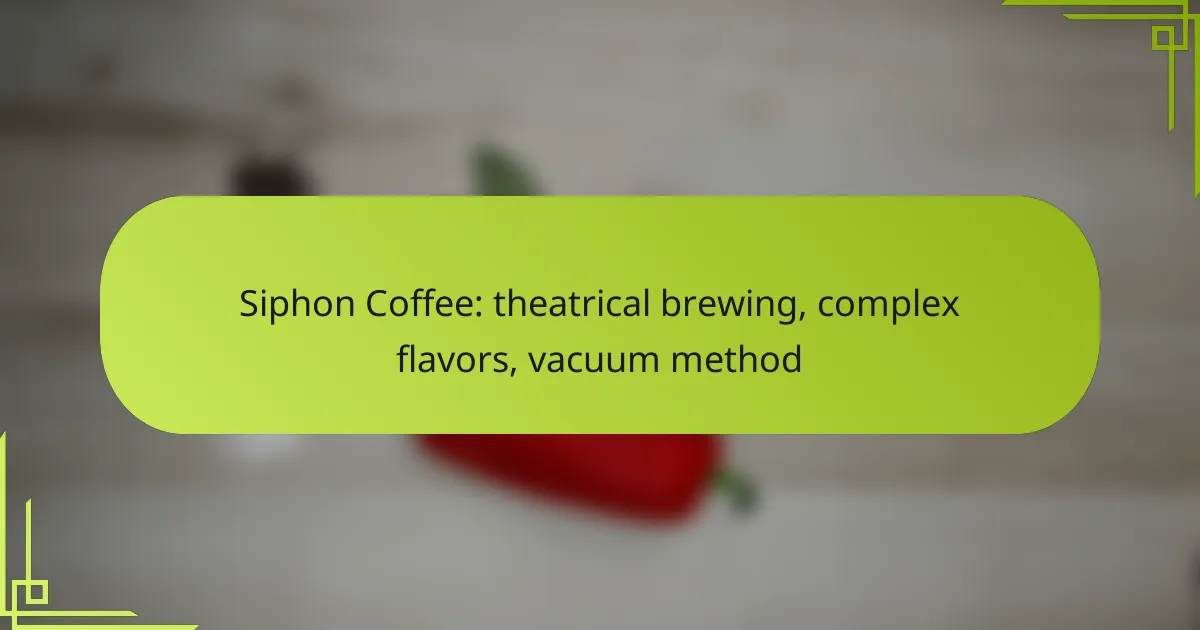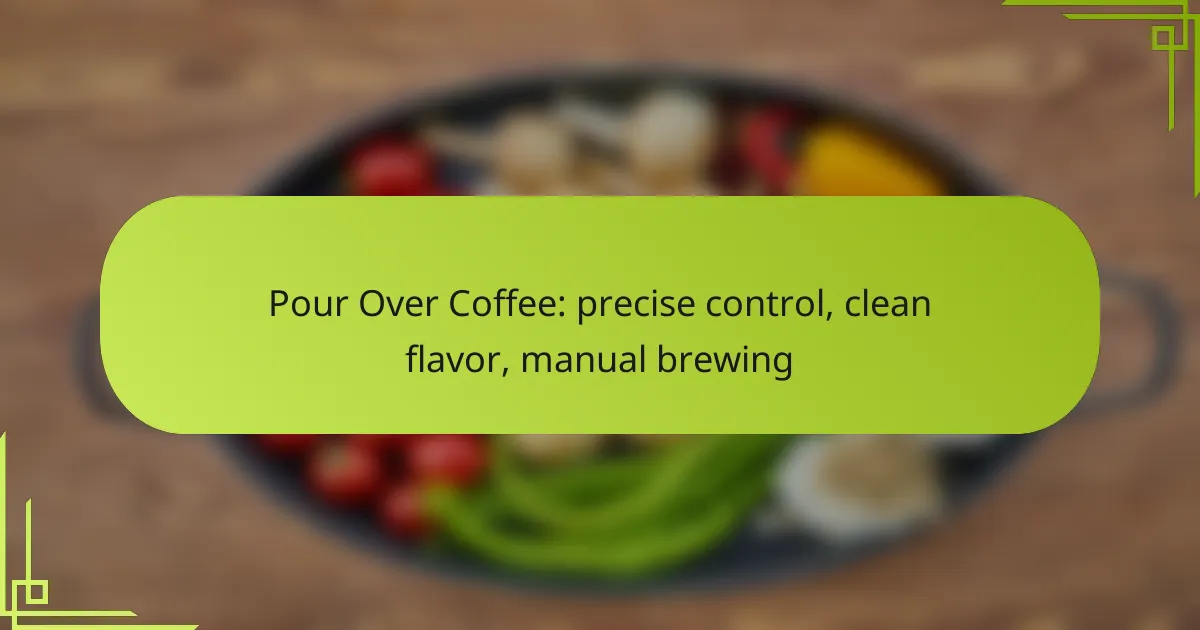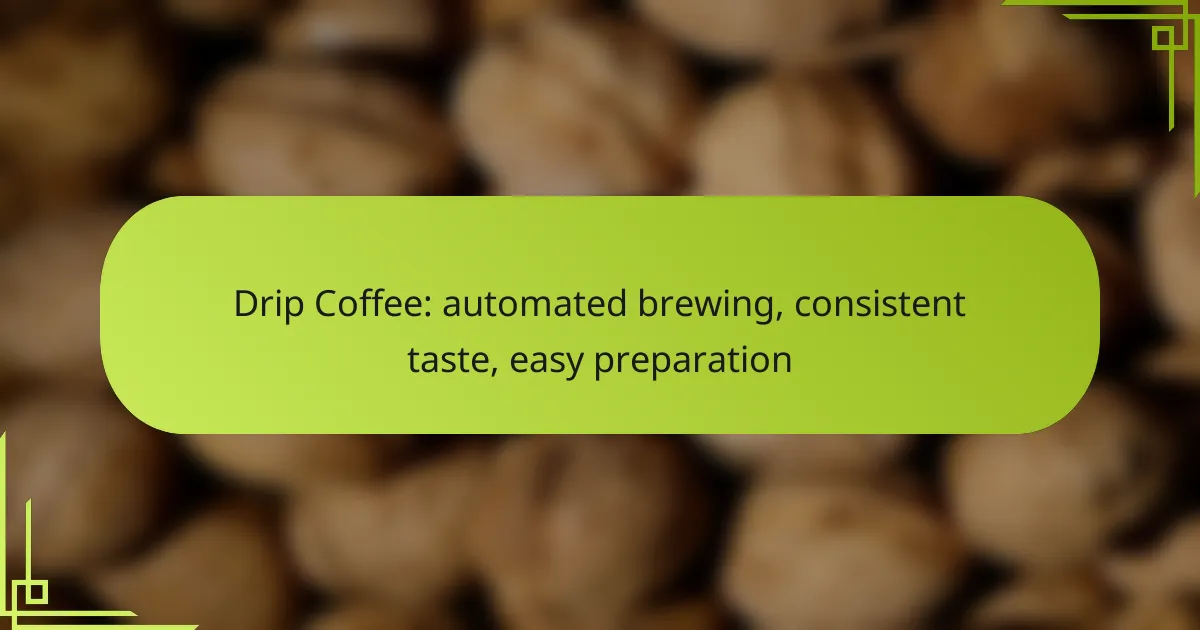French Press coffee is renowned for its full-bodied taste and thick texture, achieved through a simple steeping method that extracts rich flavors and oils from the coffee grounds. By using coarse coffee grounds and hot water, this traditional brewing technique delivers a robust and aromatic cup that many coffee enthusiasts cherish. Selecting medium to dark roast beans further enhances the experience, making each sip a delightful journey of flavor.

How to brew French Press coffee for full-bodied taste?
To brew French Press coffee with a full-bodied taste, focus on using coarse coffee grounds, hot water, and the right steeping time. This method extracts rich flavors and oils, resulting in a thick texture that enhances your coffee experience.
Coarse grind coffee beans
Using a coarse grind for your coffee beans is essential for French Press brewing. A grind size similar to sea salt allows for optimal extraction without over-extracting bitter flavors. Aim for a ratio of about 1:15 coffee to water for a balanced brew.
Investing in a burr grinder can help achieve a consistent coarse grind, which is crucial for the best results. Avoid pre-ground coffee, as it often contains fine particles that can lead to a gritty texture.
Use hot water at 200°F
Heating water to around 200°F (93°C) is ideal for brewing French Press coffee. This temperature is just below boiling, which helps extract the coffee’s full flavor profile without scorching the grounds. A kitchen thermometer can ensure accuracy.
Using water that’s too cool may result in under-extraction, leading to a weak taste. Conversely, water that’s too hot can cause bitterness. Allow your kettle to cool for about 30 seconds after boiling to reach the right temperature.
Steep for 4 minutes
Steeping your coffee for about 4 minutes is key to achieving a rich flavor. This duration allows the coffee grounds to release their oils and flavors fully. Start your timer as soon as you pour the hot water over the grounds.
Adjust the steeping time slightly based on your taste preference; a shorter steep may yield a lighter flavor, while a longer steep can enhance bitterness. However, avoid steeping for more than 5 minutes to prevent over-extraction.
Press and pour immediately
After steeping, press the plunger down slowly and steadily to separate the grounds from the brewed coffee. Pour the coffee immediately into your cup to enjoy its full flavor and aroma. Delaying this step can lead to over-extraction and a bitter taste.
Consider serving the coffee in a pre-warmed mug to maintain its temperature. If you have leftover coffee, transfer it to a thermal carafe to prevent it from sitting with the grounds, which can alter the taste.

What are the benefits of using a French Press?
The French Press offers several advantages, including rich flavor extraction, a full-bodied texture, and an eco-friendly brewing method. This traditional coffee-making technique allows for a robust and aromatic cup of coffee that many enthusiasts prefer.
Rich flavor extraction
The French Press method excels in extracting rich flavors from coffee grounds. By steeping coarsely ground coffee in hot water for several minutes, oils and fine particles are retained in the brew, enhancing the overall taste profile. This results in a more aromatic and flavorful cup compared to drip coffee methods.
To achieve optimal flavor extraction, use a coffee-to-water ratio of about 1:15. Experimenting with steeping times, typically between four to five minutes, can also help you find the perfect balance for your palate.
Full-bodied texture
One of the standout features of French Press coffee is its full-bodied texture. The metal mesh filter allows more oils and sediment to pass through, creating a thicker mouthfeel. This contrasts with paper filters, which can absorb some of the oils and lead to a lighter brew.
For a truly satisfying experience, consider using a medium to coarse grind, which helps maintain the rich texture while preventing over-extraction. The result is a coffee that feels substantial and satisfying on the palate.
Eco-friendly brewing method
The French Press is an eco-friendly choice for coffee lovers. Unlike single-use coffee pods or paper filters, it requires no disposable materials, reducing waste significantly. The only components needed are coffee grounds and water, making it a sustainable option.
To further enhance its eco-friendliness, consider using organic coffee beans. This not only supports sustainable farming practices but also ensures a cleaner cup, free from harmful chemicals. Embracing this method contributes to a more environmentally conscious coffee culture.

What coffee beans are best for French Press?
The best coffee beans for French Press brewing are typically medium to dark roast varieties, which enhance the full-bodied taste and thick texture characteristic of this method. Choosing the right beans can significantly impact the flavor profile and overall experience of your coffee.
Medium to dark roast beans
Medium to dark roast beans are ideal for French Press because they provide a rich, bold flavor that stands up well to the brewing process. These roasts often have a lower acidity, which contributes to a smoother taste and a thicker mouthfeel.
When selecting medium to dark roast beans, look for options labeled as “full-bodied” or “rich.” Popular choices include Colombian, Sumatra, and French roasts, which all offer robust flavors that complement the French Press method.
Single-origin coffee
Single-origin coffee refers to beans sourced from a specific region or farm, allowing for unique flavor profiles that reflect their origin. These coffees often exhibit distinct characteristics, making them an excellent choice for French Press brewing.
When choosing single-origin beans, consider options from regions known for their quality, such as Ethiopia, Kenya, or Guatemala. Each region imparts different flavor notes, allowing you to explore a variety of tastes with your French Press.
Arabica vs. Robusta
Arabica and Robusta are the two primary coffee species, and they offer different flavor profiles suited for French Press. Arabica beans are generally sweeter and more complex, while Robusta beans have a stronger, more bitter taste and higher caffeine content.
For a balanced cup, consider using a blend of both Arabica and Robusta beans. This combination can enhance the body and texture of your coffee while providing a unique flavor experience. Aim for a blend that contains at least 70% Arabica for a smoother taste with the benefits of Robusta’s strength.

What are the common mistakes when using a French Press?
Common mistakes when using a French Press include using the wrong coffee grind, incorrect water temperature, and over-steeping the coffee. These errors can lead to a less than optimal brewing experience and affect the flavor and texture of your coffee.
Using fine coffee grind
Using a fine coffee grind is a frequent mistake that can result in a bitter taste and a gritty texture. The French Press works best with a coarse grind, which allows for proper extraction while preventing the coffee from becoming overly bitter. A good rule of thumb is to aim for a grind size similar to sea salt.
When using a fine grind, the coffee grounds can easily slip through the mesh filter, leading to sediment in your cup. This not only affects the mouthfeel but can also make the coffee taste harsher. Stick to a coarse grind for a smoother, fuller-bodied brew.
Incorrect water temperature
Incorrect water temperature can significantly impact the extraction process in a French Press. Ideally, the water should be between 195°F and 205°F (90°C to 96°C) when pouring over the coffee grounds. Water that is too hot can scorch the coffee, while water that is too cool may not extract the flavors adequately.
A simple way to achieve the right temperature is to bring water to a boil and then let it sit for about 30 seconds before pouring. This method helps ensure that you are brewing at the optimal temperature for the best flavor profile.
Over-steeping the coffee
Over-steeping coffee in a French Press can lead to an overly bitter and unpleasant taste. The recommended steeping time is typically between four to five minutes. Steeping for too long allows the coffee to extract too many undesirable compounds, resulting in a harsh flavor.
To avoid over-steeping, set a timer as soon as you pour the hot water over the coffee grounds. Once the time is up, press the plunger down gently and pour your coffee immediately. This practice will help maintain the desired flavor and texture of your brew.

How to clean a French Press effectively?
To clean a French Press effectively, disassemble the components and rinse them with warm water. Use a gentle brush or sponge to remove coffee residue, ensuring all parts are thoroughly cleaned before reassembling.
Disassemble the press
Begin by removing the lid and plunger from the French Press. Take apart the plunger by unscrewing the filter from the rod, separating the mesh filter and the spring. This step is crucial for accessing all areas that may harbor coffee oils and grounds.
Once disassembled, inspect each component for any stubborn residue. Pay particular attention to the mesh filter, as it can trap oils that affect the taste of future brews. A thorough disassembly allows for a more effective cleaning process.










